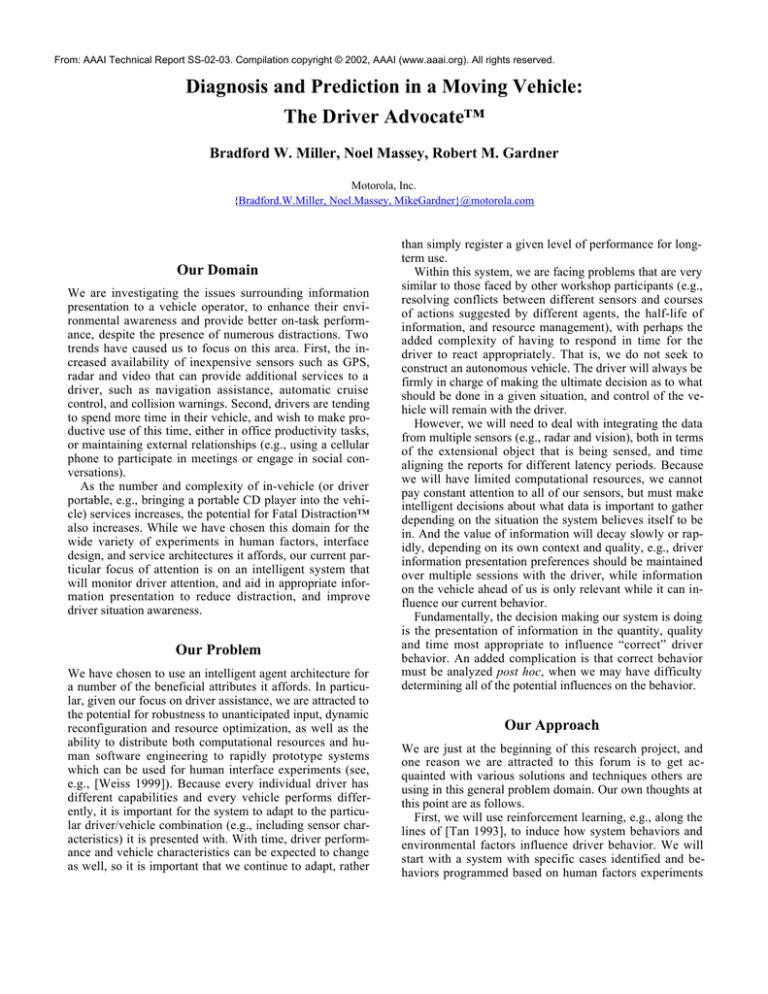
From: AAAI Technical Report SS-02-03. Compilation copyright © 2002, AAAI (www.aaai.org). All rights reserved.
Diagnosis and Prediction in a Moving Vehicle:
The Driver Advocate™
Bradford W. Miller, Noel Massey, Robert M. Gardner
Motorola, Inc.
{Bradford.W.Miller, Noel.Massey, MikeGardner}@motorola.com
Our Domain
We are investigating the issues surrounding information
presentation to a vehicle operator, to enhance their environmental awareness and provide better on-task performance, despite the presence of numerous distractions. Two
trends have caused us to focus on this area. First, the increased availability of inexpensive sensors such as GPS,
radar and video that can provide additional services to a
driver, such as navigation assistance, automatic cruise
control, and collision warnings. Second, drivers are tending
to spend more time in their vehicle, and wish to make productive use of this time, either in office productivity tasks,
or maintaining external relationships (e.g., using a cellular
phone to participate in meetings or engage in social conversations).
As the number and complexity of in-vehicle (or driver
portable, e.g., bringing a portable CD player into the vehicle) services increases, the potential for Fatal Distraction™
also increases. While we have chosen this domain for the
wide variety of experiments in human factors, interface
design, and service architectures it affords, our current particular focus of attention is on an intelligent system that
will monitor driver attention, and aid in appropriate information presentation to reduce distraction, and improve
driver situation awareness.
Our Problem
We have chosen to use an intelligent agent architecture for
a number of the beneficial attributes it affords. In particular, given our focus on driver assistance, we are attracted to
the potential for robustness to unanticipated input, dynamic
reconfiguration and resource optimization, as well as the
ability to distribute both computational resources and human software engineering to rapidly prototype systems
which can be used for human interface experiments (see,
e.g., [Weiss 1999]). Because every individual driver has
different capabilities and every vehicle performs differently, it is important for the system to adapt to the particular driver/vehicle combination (e.g., including sensor characteristics) it is presented with. With time, driver performance and vehicle characteristics can be expected to change
as well, so it is important that we continue to adapt, rather
than simply register a given level of performance for longterm use.
Within this system, we are facing problems that are very
similar to those faced by other workshop participants (e.g.,
resolving conflicts between different sensors and courses
of actions suggested by different agents, the half-life of
information, and resource management), with perhaps the
added complexity of having to respond in time for the
driver to react appropriately. That is, we do not seek to
construct an autonomous vehicle. The driver will always be
firmly in charge of making the ultimate decision as to what
should be done in a given situation, and control of the vehicle will remain with the driver.
However, we will need to deal with integrating the data
from multiple sensors (e.g., radar and vision), both in terms
of the extensional object that is being sensed, and time
aligning the reports for different latency periods. Because
we will have limited computational resources, we cannot
pay constant attention to all of our sensors, but must make
intelligent decisions about what data is important to gather
depending on the situation the system believes itself to be
in. And the value of information will decay slowly or rapidly, depending on its own context and quality, e.g., driver
information presentation preferences should be maintained
over multiple sessions with the driver, while information
on the vehicle ahead of us is only relevant while it can influence our current behavior.
Fundamentally, the decision making our system is doing
is the presentation of information in the quantity, quality
and time most appropriate to influence “correct” driver
behavior. An added complication is that correct behavior
must be analyzed post hoc, when we may have difficulty
determining all of the potential influences on the behavior.
Our Approach
We are just at the beginning of this research project, and
one reason we are attracted to this forum is to get acquainted with various solutions and techniques others are
using in this general problem domain. Our own thoughts at
this point are as follows.
First, we will use reinforcement learning, e.g., along the
lines of [Tan 1993], to induce how system behaviors and
environmental factors influence driver behavior. We will
start with a system with specific cases identified and behaviors programmed based on human factors experiments
in driving simulators. We will then introduce an evaluation
function for driver performance and distraction. This will
be used to have the system evaluate its own performance as
the system is used, as well as having inferred information
about the subjective state of the driver. We will then, for a
particular driver and a particular vehicle attempt to infer
which behaviors lead to decreased driver distraction when
the situation warrants it, and what we can do to improve
overall driver performance on task. This will involve not
only prediction about the drivers own goals (plan recognition), but being able to posit possible future scenarios
based on current choices, which need to be optimized over
several criteria, including the driver achieving her goal, the
driver operating the vehicle in a safe manner (which may
involve interactions with and estimates of the safety of
other vehicles and people near the driver’s vehicle), and
making sure all global constraints (e.g., socially imposed
rules on dri ving behavior such as obeying speed limits or
not running over children in a school zone) will hold.
References
Tan, Ming, 1993. Multi-Agent Reinforcement Learning:
Independent vs. Cooperative Agents. In Proceedings of the
Tenth International Conference on Machine Learning,
Amherst, MA. 330—337.
Weiss, Gerhard, ed. 1999. Multiagent Systems. Cambridge, Mass.: The MIT Press. ISBN 0-262-23203-0

